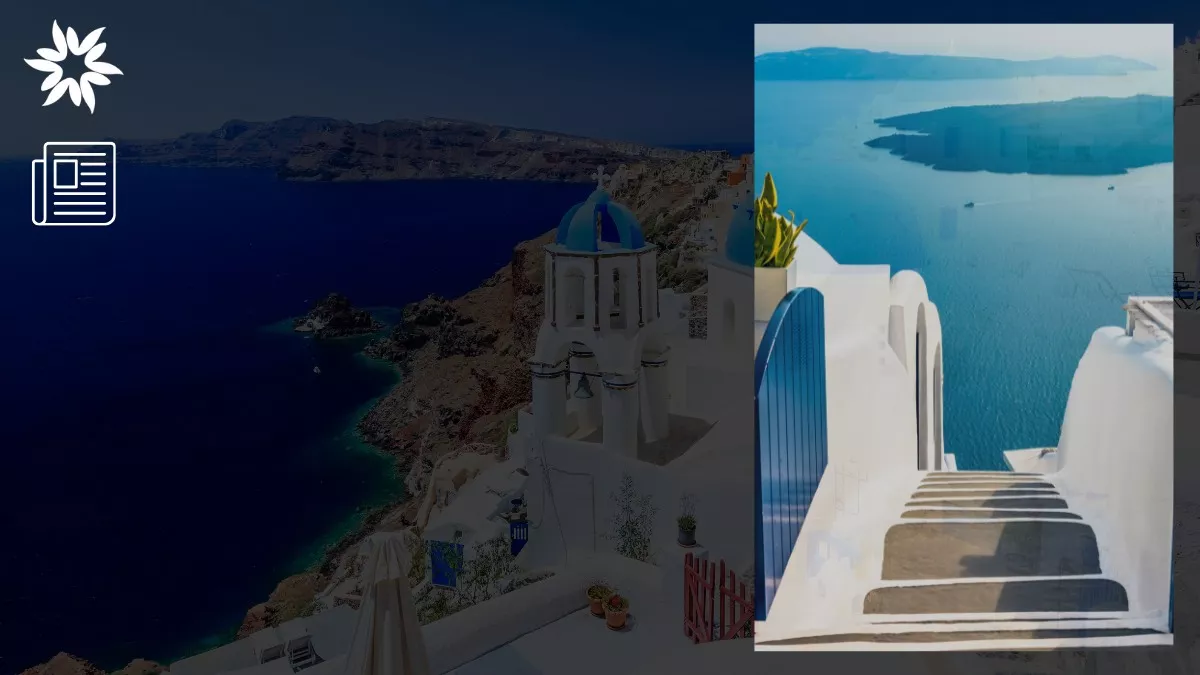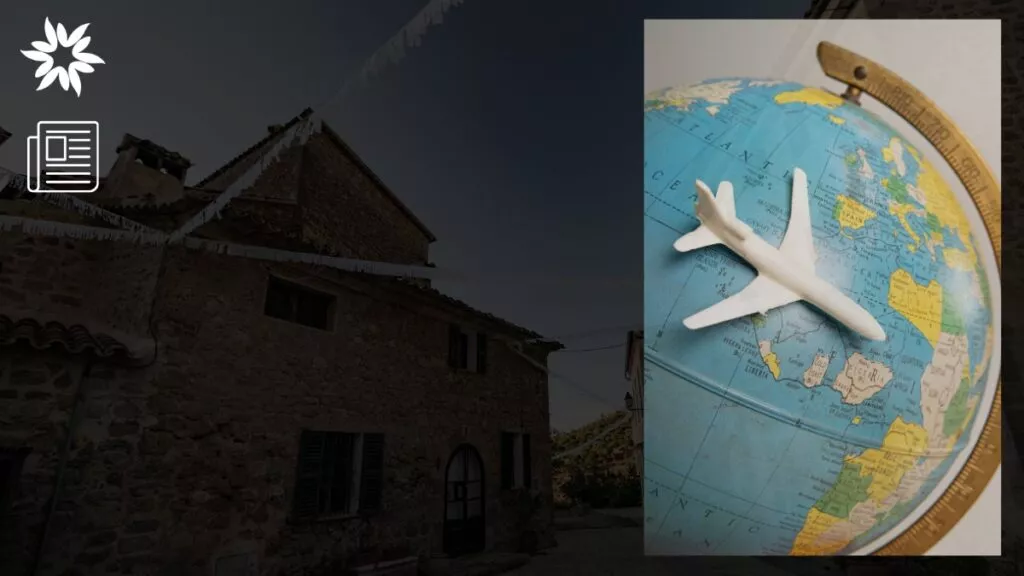It’s been years since you have wanted to discover Greece, but wonder where to start, what to see, and what the best destinations in Greece are. With so many islands, ancient ruins, and beautiful towns, it’s easy to feel stuck just picking a starting point.
That’s why this guide is here—to make it simple. We pulled together the top 10 places to visit in Greece for 2025. Each destination has been picked for its beauty, history, culture, and experience, and 2025 is the perfect time to explore them.
Key Takeaways
- Visit both cities and islands. Spend time in Athens or Thessaloniki, then head to islands like Santorini or Corfu to see the best of Greece.
- Go in May, June, or September. The weather is great, prices are better, and you avoid the summer crowds.
- Book tours and ferries early. Top activities and tickets sell out fast, especially for places like Meteora, Navagio Beach, and the Acropolis.
1. Santorini
Santorini is one of the most famous places to visit in Greece, and there are clear reasons why it belongs in the Top 10 for 2025.
First of all, the island’s landscape is one of a kind. About 3,600 years ago, a massive volcanic eruption shaped Santorini’s steep cliffs and created a large sunken crater called a caldera. Today, villages like Oia and Fira sit on top of these cliffs. Their whitewashed houses with blue-domed roofs are easy to recognize and are some of the most photographed places in the world. From almost every spot, visitors can enjoy wide, breathtaking views of the Aegean Sea.
Santorini’s beaches are very different from typical beaches. Because of the volcanic activity, the island has beaches with unusual sand colors. For example, Red Beach near Akrotiri has red sand and high red cliffs. On the other hand, Perissa and Kamari beaches are known for their black sand and smooth black pebbles. This mix of red and black beaches makes Santorini’s coastline stand out compared to other islands.
Next, Santorini is important for its history and archaeological sites. One major site is Akrotiri, a Bronze Age town that was buried under volcanic ash after the eruption. It is often called the “Pompeii of the Aegean” because the ash preserved frescoes, pottery, and buildings. Another place worth visiting is the ancient city of Thera, located on Mesa Vouno mountain, where you can see ruins from the Hellenistic, Roman, and Byzantine periods.
Santorini is also known for its local food and wine. The island’s volcanic soil is rich in minerals, helping farmers grow special products like cherry tomatoes, white eggplants, and capers. Santorini’s vineyards produce wines from the Assyrtiko grape, known for being crisp and full of minerals. Travelers can enjoy wine tastings at local wineries while trying dishes made from fresh, local ingredients.
Santorini also offers good opportunities for outdoor activities. One popular option is hiking from Fira to Oia, a scenic trail along the caldera that gives amazing views of the sea and the villages. Another popular activity is taking a boat trip to the volcanic islands of Nea Kameni and Palea Kameni, where visitors can hike across active craters and swim in natural hot springs.
2. Athens
Athens, one of the most beautiful places in Greece, is known as the cradle of Western civilization, where democracy, philosophy, and art took strong roots. The Acropolis is the city’s biggest landmark, a UNESCO World Heritage Site. Standing at the center is the Parthenon, a temple built for the goddess Athena. Right next to it, the Acropolis Museum holds more than 4,250 ancient objects, from the Greek Bronze Age to the Roman and Byzantine periods. Visiting these sites gives you a real sense of how much Greece has shaped the world.
Athens has a busy cultural life, too. The National Archaeological Museum is one of the best in the world for ancient artifacts. Every summer, the Athens Epidaurus Festival takes over, hosting concerts, plays, and operas at famous venues like the Odeon of Herodes Atticus, an ancient stone theater still in use today.
Food is another reason Athens is worth a stop. You can find traditional dishes like souvlaki and moussaka in small tavernas, but the city also has modern restaurants where chefs play with Greek flavors in new ways.
Neighborhoods in Athens each have a different vibe. Plaka is the oldest part, full of narrow streets, neoclassical houses, souvenir shops, and small cafes. Kypseli and Pangrati are newer hotspots with modern art spaces, stylish bars, and trendy cafes.
The city is also great for outdoor activities. Mount Lycabettus is the highest hill in Athens and offers a full view of the city and the Aegean Sea. Thanks to Athens’ Mediterranean weather, you can explore archaeological sites, watch movies in open-air cinemas, or relax at rooftop bars almost any time of the year.
3. Mykonos
Mykonos is a popular island in the Cyclades. It is well known for its beaches, luxury hotels, and nightlife. Paradise Beach and Super Paradise Beach are two of the most popular spots, where parties often start in the afternoon and go on until early morning. The beach clubs here are lively, and a lot of people come to the island mainly for the music, the DJs, and the social scene.
But if you’re not into partying, the island has some of the nicest beaches in Greece. Elia Beach is a good choice if you want space to swim or try things like jet skiing and parasailing. If you want something quieter, Agios Sostis Beach is more laid-back, without loud music or big crowds.
Mykonos also has a real history. A short boat ride takes you to Delos, one of the most important archaeological sites in Greece.It’s a UNESCO World Heritage Site full of ancient ruins, temples, and an old theater. Back on Mykonos, landmarks like the Panagia Paraportiani church and the old windmills in Chora town show a different side of the island beyond the beaches.
Chora itself is worth exploring. It’s full of narrow streets, whitewashed houses, small churches, and shops. Little Venice, where the buildings sit right above the water, is especially pretty around sunset.
Food is another big reason to visit. You’ll find local tavernas serving traditional dishes like kopanisti cheese and louza sausage, but also modern restaurants offering Mediterranean and international food.
4. Corfu
Corfu is known as the “Emerald Island” because it’s so lush, easily making it one of the best places in Greece. It gets more rain than other Greek islands, which means it’s full of olive trees, cypress trees, and thick greenery. This makes it feel very different compared to the dry, rocky look you find on many other islands.
Corfu also has a lot of history. From the late 1300s to the late 1700s, it was ruled by the Venetians. Their influence is easy to see, especially in Corfu Town. The Old Town, which is now a UNESCO World Heritage Site, has narrow stone streets, pastel-colored buildings, old churches, and open squares. Some of the island’s most important landmarks are the Old Fortress, the New Fortress, and the Palace of Sts. Michael and George, and the Achilleion Palace, which was built by Empress Elisabeth of Austria.
Besides its green scenery and history, Corfu has a few places you won’t find anywhere else. Vlacherna Monastery is a small white church on its own island, connected to the mainland by a short walkway. Right next to it is Mouse Island, a tiny green island you can reach by boat. Another famous spot is the Canal d’Amour near Sidari. It’s a beach surrounded by sandstone cliffs, and according to local tradition, couples who swim through the narrow channel will get married soon.
The best time to visit Corfu is in May. The weather is warm but not too hot, about 24°C (75°F), and the crowds haven’t arrived yet. Flights and hotel prices are cheaper too, compared to the busy summer months.
5. Meteora
Meteora is one of the most impressive places you can visit in Greece in 2025. It’s a spot where huge natural rock towers meet ancient history in a way you won’t see anywhere else.
Meteora is in central Greece, close to the town of Kalambaka. The area is famous for giant rock formations that rise up to 600 meters high. On top of these rocks are six active monasteries that were built between the 14th and 16th centuries. Monks built them to live in peace and stay safe from danger. Meteora became a UNESCO World Heritage Site in 1988 because of how important it is both culturally and naturally.
The biggest and most popular one is the Great Meteoron Monastery. Others like Varlaam and Rousanou are smaller but just as beautiful, with detailed frescoes, stonework, and amazing views of the valleys below.
If you like hiking, some trails let you walk right among the rock pillars. If you like climbing, there are plenty of routes for all skill levels. It’s a great spot for outdoor adventures.
The best time to visit is either spring (April to June) or fall (September to October). The weather is cooler, the crowds are smaller, and the views are even better.
6. Zakynthos (Zante)
Zakynthos is an island in the Ionian Sea. Its most famous spot is Navagio Beach, also called Shipwreck Beach or Pirate Bay. The beach has bright blue water, giant limestone cliffs, and the wreck of the MV Panagiotis sitting right in the sand. If you’ve seen a postcard of Greece, there’s a good chance it was Navagio.
Upon the northern coast, you’ll find the Blue Caves. These sea caves get their deep blue color from the sunlight bouncing off the white rocks and water. You can visit them by boat or kayak. A lot of tours visit the Blue Caves and Navagio Beach on the same trip.
Zakynthos is also a major spot for sea turtles. Marathonisi, also called Turtle Island, is part of the National Marine Park. It’s a nesting ground for loggerhead turtles. You can’t go on the beaches during nesting season, but you can take boat tours around the island and watch from a distance without disturbing the turtles.
If you want a quieter swim, head to Porto Limnionas. It’s a beautiful cove surrounded by cliffs, great for snorkeling. Nearby, the Keri Caves are also worth checking out—you can swim into them if you visit by boat.
There’s more to Zakynthos than beaches. Villages like Volimes and Keri show a quieter side of the island, with local crafts and real Greek food. In Zakynthos Town, you can visit the Church of Agios Dionysios and the old Venetian Castle.
The best time to visit Zakynthos is from May to October. May, June, September, and October are the sweet spots—warm weather without the big crowds.
7. Chania, Crete
Chania is a city in northwest Crete. The Old Venetian Harbor is the heart of Chania’s Old Town. Built in the 14th century, it’s full of narrow streets, old stone buildings, and cafes right by the water. The lighthouse at the harbor, built by the Venetians and rebuilt by the Egyptians, is one of the city’s most famous landmarks.
Chania also has some of the best beaches in Crete. Balos Beach has bright turquoise water and white sand. You can hike there or take a boat. Elafonisi Beach is known for its pink sand and shallow lagoons—great for families. Falassarna Beach is big, sandy, and good for swimming and water sports.
If you like hiking, Samaria Gorge is one of the best hikes in Greece. The trail is 16 kilometers long, cutting through cliffs and forests. You’ll see rare plants and animals along the way.
Chania’s food is another reason to visit. You’ll find traditional Cretan dishes made with local ingredients in small tavernas, but there are also modern restaurants putting new twists on old recipes.
For history lovers, Chania has two great museums. The Archaeological Museum has artifacts from the Neolithic to Roman times. The Maritime Museum shows off Crete’s naval history with ship models and historical displays.
8. Lindos, Rhodes
Lindos is a historic village on the island of Rhodes. The main highlight is the Acropolis of Lindos. It’s on a hill above the village and has ruins from different eras, including the Doric Temple of Athena Lindia, a Hellenistic stoa, and medieval fortress walls. From the top, you get wide views of the Aegean Sea and the whitewashed houses below.
Lindos is also known for its beaches. Lindos Beach is sandy with clear, shallow water—good for swimming and sunbathing. St. Paul’s Bay is smaller, more sheltered, and perfect for snorkeling. It’s also a hit for weddings due to the scenery.
The village itself is full of narrow cobbled streets, white houses, small shops, and rooftop restaurants. The Church of Panagia, built in the 14th century, is one of the standout spots, especially for its old frescoes and traditional architecture.
The best time to visit Lindos is in spring (March to early June) or autumn (September to early November), when the weather is warm and the crowds are smaller.
9. Assos, Kefalonia
Assos is a small village on the island of Kefalonia. The village sits on a narrow piece of land surrounded by pine trees and the bright blue Ionian Sea. It’s known for its colorful houses, tiny streets, and a quiet harbor that feels like real, untouched Greece.
Above Assos is the old Venetian Castle, built in 1593. It was made to defend the island from pirates. You can hike up the hill to the castle ruins and get wide views over the sea and the village.
Assos is all about slowing down. The local beach has clear, calm water that’s perfect for swimming and relaxing. You can also rent a small boat to find hidden coves along the coast. The sunsets here, especially from the waterfront or the castle, are some of the best on the island.
It’s easy to reach Assos by car. It’s about a 50-minute drive from Argostoli, the main town in Kefalonia. The road gets narrow and twisty near Assos, so it’s smart to drive carefully.
If you’re nearby, you should also check out Myrtos Beach, just a short drive away. It’s famous for its bright blue water and huge cliffs.
10. Thessaloniki
Thessaloniki is the second-largest city in Greece. It’s located in the north and is known for its cultural history and modern atmosphere. The city has monuments from the Byzantine and Ottoman periods.
The White Tower is the symbol of Thessaloniki. It’s from the 15th century and you can climb to the top for wide views over the city and the sea.
The Church of Saint Demetrius is another major stop. It’s a UNESCO World Heritage Site and one of the city’s oldest churches, known for its detailed mosaics.
You’ll also find the Rotunda and the Arch of Galerius, two Roman monuments that show Thessaloniki’s deep ancient history.
For museum lovers, the Archaeological Museum of Thessaloniki has artifacts from Macedonia’s royal tombs and ancient times. The Museum of Byzantine Culture covers the city’s Byzantine past and has won awards for its collection. The Atatürk Museum, where Mustafa Kemal Atatürk was born, is also open for visitors.
Thessaloniki has plenty of lively neighborhoods, too. Ladadika District is full of bars, restaurants, and live music spots. Ano Poli, the old town up on the hill, has narrow streets, old houses, and views over the whole city.
The food scene is one of the best parts. Traditional Greek tavernas sit next to modern restaurants. Bougatsa, a pastry filled with cream or cheese, is a must-try, along with fresh seafood.
Book Your Trip and Fall in Love with Greece
You’ve waited long enough to explore Greece, and this year is the perfect time to make it happen. The crowds are smaller, the prices are better, and there’s a whole country full of history, amazing food, and real charm just waiting for you.
Book your flights, find your favorite spot on the map, and get ready for sunsets you’ll never forget, meals that will have you dreaming for months, and a trip that feels like a once-in-a-lifetime adventure.
Trust me, once you get there, you’re going to fall in love with it. Greece is ready to steal your heart.
But before you go, I’m sure you’d appreciate these hacks for packing your suitcase. You’ll be surprised how much extra room you can make!








